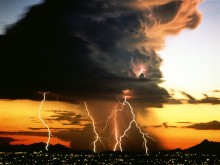
When you flip a light switch in your home, the lights come on. That’s how things work.
We pretty much take it for granted. We rarely question how it really works behind the scenes. It’s very cool that it does, but there is an enormous amount of machinery and manpower that is required to make it happen.
The fact is that power generation takes about $378 billion, or roughly 1.4% of the total economy to keep power flowing to approximately 319 million US citizens and all of US industry. 1.4% is a very small number and says that the utility industry is incredibly efficient at generating and delivering power.
Generating electricity boils down to turning a generator and sending power down a pair of wires. This, by the way, is where Edison had it wrong. DC power is very inefficient over long distances. Tesla has this part right, because as we have found, AC power does much better, but involves some complexity.
At the end of the day, electricity has proven to be, by far, the most efficient energy source for doing work. We see the result of the various types of work from making cars to keeping a refrigerator cold, operating semiconductor fabs to make all our cool electronic toys, you name it.
In recent years there has been widespread debate about how we make electricity, what fuels will we use to turn the turbine. Will it be coal and natural gas combustion to heat water and make steam? Anything that burns fuel causes unwanted byproducts, pollution of some type, although the industry has done a great deal to minimize these effects.
Nuclear power uses the heat from radioactive elements to make steam and turn the generator. While nuclear power plants in the past have had some terrible failures, Chernobyl and Fukusima, newer reactor designs have been developed that are completely safe and we need to consider them as part of our overall portfolio.
Alternative energy, solar power and wind power, have grown in the last few years as an option, but these sources are intermittent and storage technology has not kept pace. So there is a problem, because if there is too much intermittent energy on the network, it introduces unpredictability. Maybe your lights will still turn on, but large users like semiconductor fabs may be forced to reduce their operations due to shortage.
So the question is; who decides how we manage and implement resources to keep everything running? The short answer is the utility companies, but in many service areas, the utility companies are under the authority of the State government where they operate. State legislators are often not technically versed in the issues and make regulations that are somewhat ?wishful thinkingi?? instead of letting the experts do their jobs.
To make matters worse, the Department of Energy has created Renewable Portfolio Standards (RPS) and offered the States inducements (federal funding) to conform to these guidelines. Which is why we are seeing so much wind and solar coming into the market.
There is no national discourse on the subject. Voters aren’t part of the equation. So who gets to decide where electricity comes from? Definitely NOT you or me.
Leave a Reply
You must be logged in to post a comment.